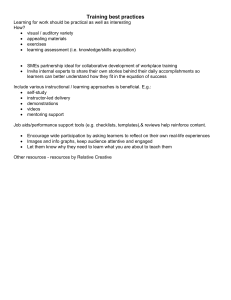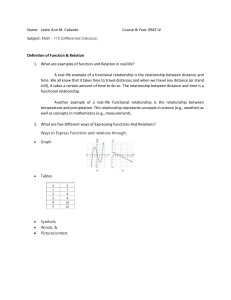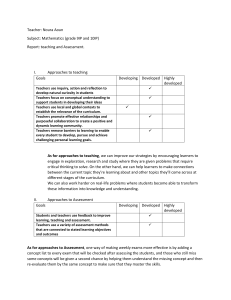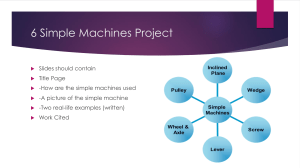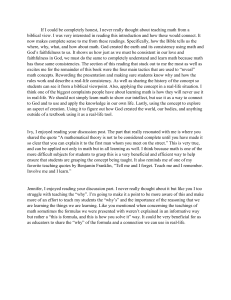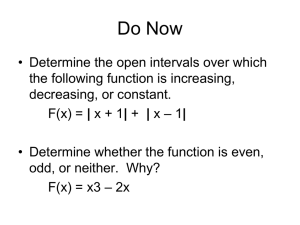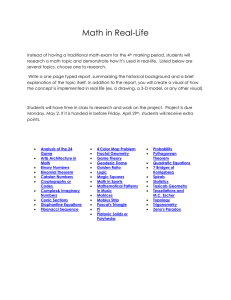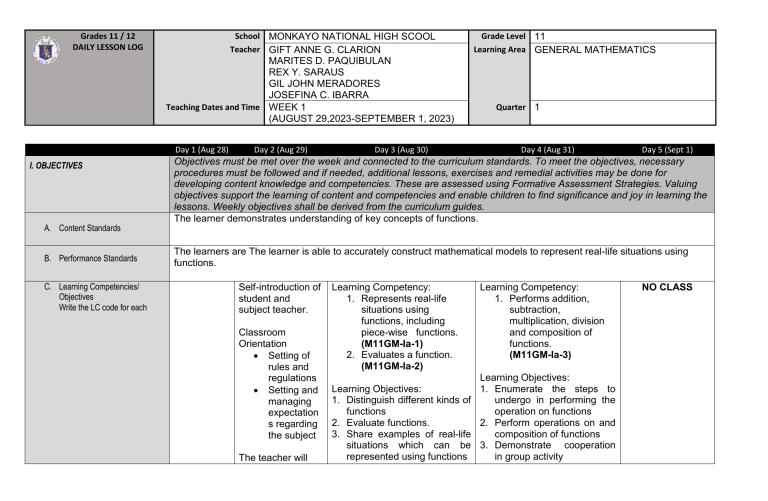
Grades 11 / 12
DAILY LESSON LOG
School MONKAYO NATIONAL HIGH SCOOL
Teacher GIFT ANNE G. CLARION
MARITES D. PAQUIBULAN
REX Y. SARAUS
GIL JOHN MERADORES
JOSEFINA C. IBARRA
Teaching Dates and Time WEEK 1
(AUGUST 29,2023-SEPTEMBER 1, 2023)
Day 1 (Aug 28)
I. OBJECTIVES
A. Content Standards
B. Performance Standards
C. Learning Competencies/
Objectives
Write the LC code for each
Day 2 (Aug 29)
Day 3 (Aug 30)
Grade Level 11
Learning Area GENERAL MATHEMATICS
Quarter 1
Day 4 (Aug 31)
Day 5 (Sept 1)
Objectives must be met over the week and connected to the curriculum standards. To meet the objectives, necessary
procedures must be followed and if needed, additional lessons, exercises and remedial activities may be done for
developing content knowledge and competencies. These are assessed using Formative Assessment Strategies. Valuing
objectives support the learning of content and competencies and enable children to find significance and joy in learning the
lessons. Weekly objectives shall be derived from the curriculum guides.
The learner demonstrates understanding of key concepts of functions.
The learners are The learner is able to accurately construct mathematical models to represent real-life situations using
functions.
Self-introduction of
student and
subject teacher.
Classroom
Orientation
Setting of
rules and
regulations
Setting and
managing
expectation
s regarding
the subject
The teacher will
Learning Competency:
1. Represents real-life
situations using
functions, including
piece-wise functions.
(M11GM-Ia-1)
2. Evaluates a function.
(M11GM-Ia-2)
Learning Competency:
1. Performs addition,
subtraction,
multiplication, division
and composition of
functions.
(M11GM-Ia-3)
Learning Objectives:
Learning Objectives:
1. Enumerate the steps to
1. Distinguish different kinds of
undergo in performing the
functions
operation on functions
2. Evaluate functions.
2. Perform operations on and
3. Share examples of real-life
composition of functions
situations which can be 3. Demonstrate cooperation
represented using functions
in group activity
NO CLASS
give Diagnostic
Test to gauge the
previous learnings
of the students
regarding the
subject.
Functions and Their Graph
II. CONTENT
III. LEARNING RESOURCES
A. References
1. Teacher’s Guide pages
2. Learner’s Materials pages
3. Textbook pages
4. Additional Materials from
Learning Resource (LR) portal
B. Other Learning Resources
IV. PROCEDURES
A. Reviewing previous lesson or
presenting the new lesson
Pages 1-14
Pages 1-9; 10-12
Functions and Their Graph
Pages 14-22
Pages 13-20
These steps should be done across the week. Spread out the activities appropriately so that students will learn well. Always be guided by demonstration of learning by the students which you can infer from formative assessment activities. Sustain learning
systematically by providing students with multiple ways to learn new things, practice their learning, question their learning processes, and draw conclusions about what they learned in relation to their life experiences and previous knowledge. Indicate the time
allotment.
Given the following models,
identify the kind of function
being shown on each item by
choosing from the list in the
box.
Linear function
Quadratic function
Polynomial Function
Piecewise Function
One-to-One
Many-to-One
1)
2)
3)
4)
f(x) = 7x
g(x) = x2
h(x) = x3 + 2x2 – x +1
{(1,2), (2,4),(3,9)}
A.
For the review on evaluating
functions, the teacher will
conduct a short drill through a
game.
Instructions: Each group shall
be given 1 tag board, rag and
a chalk.
The teacher will
present to the class of what
function to evaluate. After the
allotted time, they will be
asked to raise their tag boards
for answers to be checked.
1) f(x) = 5x – 8; if x= 9
2) g(x) = x2 – 7; if x = -4
3) h(x) = (x – 4)(x + 4); if x = 0
5)
Facebook
Instagram
Twitter
6)
6) {(
7)
8,1 x 5
8) 8 1.00 x, x 5
Social
Media
B.
For the presentation of the
new lesson, GALLERY WALK
ACTIVITY will be used.
The teacher instructs that the
class will be divided into 5.
Each group shall be assigned
to a station (option will be
according to how sitio is
named in the barangay) in a
gallery
)}
walk for 3 minutes.
When they are in the station,
they will have to discuss the
poster where an operation is
used on the function. This
step repeats until all stations
are covered.
Gallery Walk
(Zone 1): ADDITION OF
FUNCTIONS
Given: f(x) = x + 5; g(x) = x –
1; find (f + g) (x)
(f + g) (x) = f(x) + g(x)
= (x +5) + (x -1)
= x + 5 +x-1
(f + g)(x) =2x +4
(Zone 2): SUBTRACTION OF
FUNCTIONS
Given: g(x) = (x2 + x – 1); f(x) =
x2 - 1;find (f-g)(x)
(f-g)(x) = f(x) – g(x)
= (x2 – 1) - (x2 + x – 1)
= x2 – 1- x2 - x + 1
(f-g)(x) = -x
(Zone 3): MULTIPLICATION
OF FUNCTIONS
Given:f(x)=x2 + 5x + 6 ; g(x) =
x + 1; find (fg)(x)
x2 + 2x + 1
x+2
(fg)(x)= f(x)g(x)
= x2 + 5x + 6 x + 1
x2 + 2x + 1 x + 2
= (x+3)(x+2) x + 1
(x+1)(x+1) x+2
= x+3
x+1
(Zone 4):
DIVISION OF
FUNCTIONS
Given:
x 2 2x 1
x 1
f ( x) 2
; g ( x)
;
x2
x 5x 6
f
find x
g
f
f ( x)
x =
g ( x)
g
= x2 + 2x + 1 ÷ x + 1
x2 + 5x + 6
x+2
= (x+1)(x+1) x + 2
(x+3)(x+2) x+1
f
x 1
x =
x3
g
(Zone 5): COMPOSITION OF
FUNCTIONS
Given: f(x) = x + 1; g(x) = 2x;
find (f o g)(x) = f(g(x))
B. Establishing a purpose for the
lesson
C. Presenting examples/instances
of the new lesson
(f o g)(x) = f(g(x))
= g(x) + 1
= 2x + 1
The teacher lets the students
The teacher emphasizes that it
realize that being able to model is good to have learned
real-life situations will help us
operations on algebraic
understand better the concept
expressions, so that
of functions including pieceoperations on functions will
wise functions.
just be easy because there are
some real life situations that
may involve operations which
can be represented by
functions
(Contextualization &
The teacher uses the same
Localization)
given in the gallery walk, now
presented as one on the
The teacher divides the class board.
into groups with five members,
do a 2 – part Activity.
First part, requires each
group to come up with 2 real –
life examples of functions
modelled
by
a
mapping
diagram and set of ordered
pairs.
Second part, asks the
group to choose which best
represents a real-life situation:
A jeepney passenger pays
P8.00 for the first 5 km as fare
and an additional P1.00 for
every succeeding distance x in
kilometer.
8,1 x 5
A. f(x) =
8 1.00 x, x 5
B. f(x) = 8 +1.00x
D. Discussing new concepts and
practicing new skills #1
E. Discussing new concepts and
practicing new skills #2
F. Developing mastery (leads to
Formative Assessment 3)
The teacher discusses with the
students why the real-life
examples they give illustrate
functions and of why they have
chosen such representation for
part 2 in the activity.
From the presented examples
on the board, the teacher will
ask the students of the steps
that were used given a
particular
operation
on
functions to arrive at an
answer.
The teacher explains that
The teacher will give other
Choice A in the second part of
examples to discuss for further
the activity is a representation
understanding of the lesson.
of a piece-wise function.
Given: f(x) = 1/x; g(x) = 1/x2 ;
Explain further that Piece-wise
find (f+g)(x) ; (f-g)(x); (fg)(x);
function is used whenever it is
(f/g)(x) and (f o g)(x)
not possible to represent a
Answers: (f+ g)(x) = (x +1)/x2;
situation with just one equation. (f-g)(x) = (x – 1)/x2; (fg)(x) =1/
Given a function f(x) = 2x, what x3; (f/g)(x) = x; (f o g)(x) = x2
is the result when you replace x
by 2 in the function? If x = 0? If
x = -1?
Tell to the class that the one
done is evaluating functions.
Steps
to
undertake
in
evaluating functions are
1) Substitute the value to the
variable.
2) Do the operation to find the
value of the function.
Activity: Evaluate the following
functions.
1) f(x) = 3x ; if x = 4
2) f(x) = x/2, if x = 0
3) f(x) = 2x3 – 8, if x = -3
4)f(x) = x - 3 , if x = 12
The teacher asks students to
practice the following numbers
by groups of five.
Find (f+g)(x); (f-g)(x); (fg)(x);
(f/g)(x); (f o g)(x), given the
following:
1) f(x) = x/2 and g(x) = 2x
2) f(x) = (x +5)/(x-1) and g (x) =
(x2-3x +2)/(x2 – 25)
G. Finding practical applications of
concepts and skills in daily living
Ask
students
of
real-life
situations
which
can
be
represented by a piece-wise
function. (Contextualization &
Localization)
Possible Answers:
Internet
payment; Taxi fare
Secondly, ask them to think of
situations where evaluation of
functions can be applied.
Example answers: when
computing for salary; when
computing for fare; when
purchasing items
H. Making generalizations and
abstractions about the lesson
The teacher summarizes the
lesson through asking the
following questions
1) What are the different
types of functions?
2) What are ways to
represent functions?
3) How do we evaluate
functions?
Teacher presents to the class
an example where operation
on functions can be applied.
The idea of what operation can
be used will be from the
students. (Contextualization &
Localization)
Example: Mat Hematics has
two jobs to attend to in a day.
He works for 4 hours as cook
in a carenderia and his pay for
such is defined as f(x) = 200x.
In the afternoon he also works
for the same number of hours
as English tutor to the Koreans
and his pay is described as
g(x) = 500x. What operation
on function can be used in this
particular example? Answer:
Addition
The teacher summarizes the
lesson by letting the students
fill the blank.
1. In
adding
and
subtracting
functions,
We must remember that
________.(Possible
answers: only similar
terms can be combined
through addition and
subtraction;
when
fractions are given,
finding the LCD is the
first thing to do.)
2. In multiplying functions,
remember
to
____________.(Possibl
e answer: factor or to
rewrite the given into
I.
Evaluating learning
A.
1) Which best represents the
situation below.
The sweet corn sold in the
canteen is at P7.00. If I want to
buy x pieces of sweet corn,
how much will I pay?
A. f(x) = 7 + x
B. f(x) = 7x
C. f(x)= 7
2) Represent the situation in
any possible model.
With Santos family, mama
and the eldest child are both of
blood type A, papa, youngest
and the middle child are all
blood type B.
B.
Evaluate the following:
1) h(x) = x3 – x2 +x – 2, if x =
0
2) g(x) = (x + 4)(x – 1) , if x = 2
3) f(x) = 1/x, if x = 3
prime factors)
3. In dividing functions, do
not
forget
to
___________.
(Possible
answer:
factor and to get the
reciprocal of the divisor
before proceeding to
multiplication.)
In composition of functions,
like(f o g)(x), it means that the
x of _____ must be replaced
by _____. (Possible answer:
f(x), g(x) )
A. Do all the operations and
composition on functions.
(For girls): f(x) = 3/2x and g(x)
=x
(For boys): f(x)= 2x /3 and
g(x) =2x
J. Additional
activities
application or remediation
for
4) h(x) = 4x – 2, if x = 1
5) f(x) = 5(x+2) , if x = 4
Answer page 9 of your book
numbers 1-3 & 5.
Answers:
1) any value except 4 and 6
2) b
3) V and W
5) S (n) = 600n
V. REMARKS
VI. REFLECTION
A. No. of learners who earned 80%
in the evaluation
B. No. of learners who require
additional activities for
remediation
C. Did the remedial lessons work?
No. of learners who have
caught up with the lesson
D. No. of learners who continue to
require remediation
E. Which of my teaching strategies
worked well? Why did these
work?
F. What difficulties did I encounter
which my principal or supervisor
can help me solve?
G. What innovation or localized
materials did I use/discover
which I wish to share with other
teachers?
Requires teachers to reflect on and assess their effectiveness (Reflect on your teaching and assess yourself as a teacher. Think about your students' progress this week. What works? What else to be done to help
the students learn? Identify what help your instructional supervisors can provide for you so when you meet them. you can ask them relevant questions.)
Prepared by:
Approved by:
GIFT ANNE G. CLARION
Teacher II
RONALD A. DERANO
Asst. School Principal II
MARITES D. PAQUIBULAN
Teacher II
REX Y. SARAUS
Teacher II
GIL JOHN MERADORES
Special Science Teacher I
JOSEFINA C. IBARRA
Teacher II
